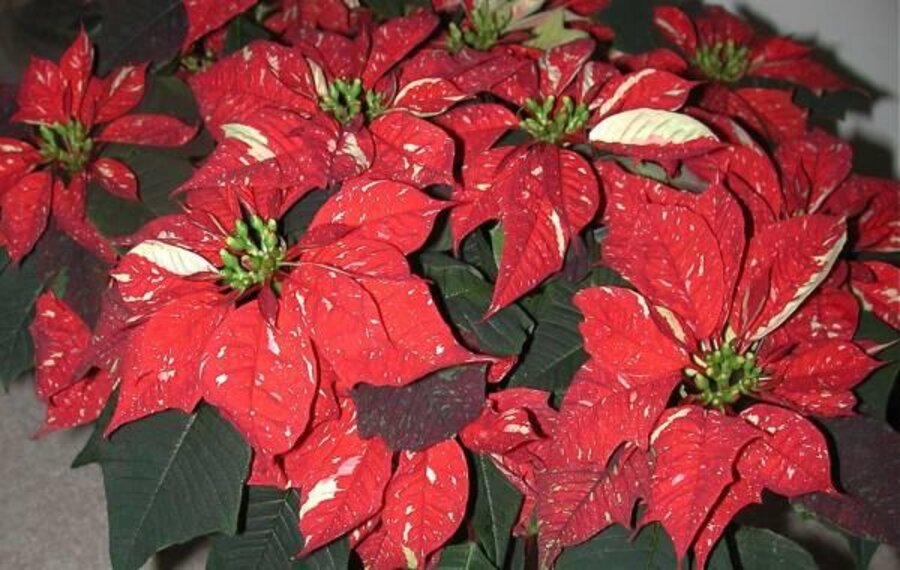Showy poinsettias an easy way to brighten holiday homes
Loading...
When we think about “decking the halls” for the holiday season, most of us envision boughs of holly, evergreen wreaths, and fragrant firs or pine. But in addition to traditional greenery, one plant has become a Christmas icon -- the poinsettia. With more than 65 million sold each year, this colorful plant has moved from the desert into three-quarters of American homes to become a holiday superstar.
The poinsettia is a Euphorbia, a succulent from the arid regions of Central America. It was named after Joel R. Poinsett, a Charleston,S.C., native who was appointed ambassador to Mexico in 1825. Poinsett was a keen gardener who was captivated by the plant’s vivid color. The bright scarlet objects many thought to be “flowers” were not flowers at all, but petal-like leaves called bracts. The actual flowers are those little yellow dots at the center of the bracts.
Because the yellow flowers and attractive bracts emerge during the holiday season, the poinsettia has been a part of Christian celebrations for hundreds of years. In the 17th century, Franciscan priests in Mexico carried poinsettias in nativity processions. The Aztecs were said to have prized the plant for its color and medicinal properties.
Although poinsettias were well known in Mexico and Central America, it was a family of German immigrants who spied the plants in the desert and created the Christmas favorite we know today.
In the early 1900s, Albert Ecke and his family left Germany to establish a farm in California. One day his son Paul noticed an unusual plant growing in the wild and decided to develop it as a cut flower. Before long, the family’s fields of poinsettias in Hollywood became a huge attraction.
In the 1920’s an amateur hybridizer in New Jersey bred a poinsettia called Oak Leaf, which was the first to resemble modern varieties. The Eckes family further developed the plant, then devised a system to distribute cuttings to nurseries throughout the country. Today, the Paul Ecke Ranch holds the patents on most popular varieties and is the largest supplier of poinsettias in the world.
Of course, the traditional red poinsettia remains the top holiday choice, but interest in white, cream, pink, and mottled varieties is on the increase. In fact, the popularity of the red poinsettia has been steadily falling over the past decade thanks to the introduction of new and more colorful varieties each year. One such variety, Ice Punch, is described as cranberry red with frosty white center markings.
In addition to new colors, we can thank breeders for giving us plants that last longer and are more vigorous. Today’s poinsettias aren’t too fussy and are relatively easy to care for. Above all, don’t overwater -- plants should be kept on the dry side but don’t allow them to get bone dry. Keep them away from drafts and sources of heat like a fireplace.
Poinsettias like bright light and will drop leaves and get leggy in a location that’s too dark. A window will provide the light and cool nighttime temperatures plants need to thrive.
It’s possible to keep a poinsettia alive and blooming from year to year, but like most people, I toss mine out about mid-February. It seems sad and cruel to throw away something that was so lovely during the holidays. But by next Christmas, another showy poinsettia will catch my eye, and this year’s beautiful blooms will be just a happy memory.
Here’s hoping your holiday season will be filled with happy memories, too.
PSSST: We’ve all heard the rumors that poinsettias are poisonous. Apparently this urban legend started in 1919 when it was reported that a 2-year-old had died after eating a leaf. According to the American Society of Florists, poinsettias have been tested more than any other plant, and the verdict is they are safe for people and pets. But you still wouldn’t want to eat one.
Lynn Hunt, the Rose Whisperer, is an accredited horticultural judge and a Consulting Rosarian Emeritus for the American Rose Society. She has won dozens of awards for her writing in newspapers, magazines, and television. She grows roses and other plants in her garden on the Eastern Shore of Maryland.
Editor’s note: To read more posts by Lynn, see our blog archive. The Monitor’s main gardening page offers articles on many gardening topics. See also our RSS feed. You may want to visit Gardening With the Monitor on Flickr. Take part in the discussions and get answers to your gardening questions. If you join the group (it’s free), you can upload your garden photos and enter our next contest.





